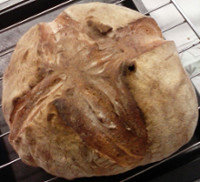Ho letto un grande post da Bill/SFNM mi sento il bisogno di condividere
Actually, it's more about the way you combine the flour and the water to minimize stickiness:
Mobile water molecules are what cause stickiness. The goal for whatever level of hydration you select is to minimize that mobility. To my way of thinking, there are two ways to approach this:
1. Breaking the flour up into smaller particles creates smaller volumes of water that can move in the solution. I always sift the flour into the water. Furthermore I only sift in about 80% of the total flour initially. After mixing until there is no visible dry flour, I allow the mixture to rest 20-30 minutes before adding the remaining flour and other ingredients and commencing with kneading.
2. Further immobilizing water by the creation of gluten structure. Of course, an overly strong gluten structure can result in a tougher crust. OTOH, the more moisture locked in that structure, the softer the crust will be when the water vaporizes and creates voids. The conflict between these two and the role of heat is an important topic for another discussion. But I've found the best gluten structure for locking in as much water as possible without creating toughness is the "stretch and fold" method or a fork mixer. But there are many ways to approach this, depending on the style of pizza you prefer.
These observations are in no way intended to be scientific description of the process. It is just a way that helps me visualize what is going on within the dough. I tend to push the hydration ratio as high as I can for Neapolitan-style pizza with a minimum of bench flour.

